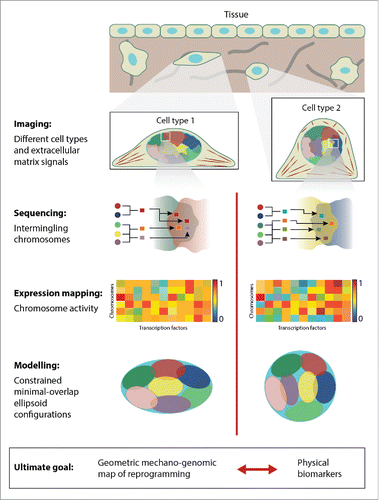Figures & data
Figure 1. A schematic depicting the proposed integrated approach to analyze the coupling between cell geometry and gene expression. As a first step we need to establish images of different cell types that are able to capture extracellular matrix signals, nuclear geometry, and 3d chromosome organization. Then this needs to be combined with high-throughput sequencing of the intermingled chromosomes to obtain a fine-grained picture of spatial gene neighborhoods. Gene expression analysis and mapping to the respective chromosomes will then provide insight into nanoscale functional gene clusters. In order to gain an integrated picture, we combine this single-cell analysis with geometric chromosome packing models. These models will allow us to predict the reprogramming paths between cell types. In addition, these combined experimental and modeling approaches will facilitate the development of physical biomarkers for cell-type specific alterations in disease states.

Figure 2. A schematic depicting cell types positioned within islands (representing for example different tissues) and potential reprogramming paths between these cell types. Cells can transition either within an island or between the islands by crossing local and global epigenetic barriers. We suggest the existence of a tight coupling between cell geometry and gene expression patterns. Thus, mechanical tuning of cell geometry and the induced chromosome positions could serve as an innovative approach to cross epigenetic barriers. Establishing a mechano-genomic map will provide a quantitative framework to understand how altering cellular homeostasis in local tissue microenvironments can lead to diseases such as cancer and fibrosis.

